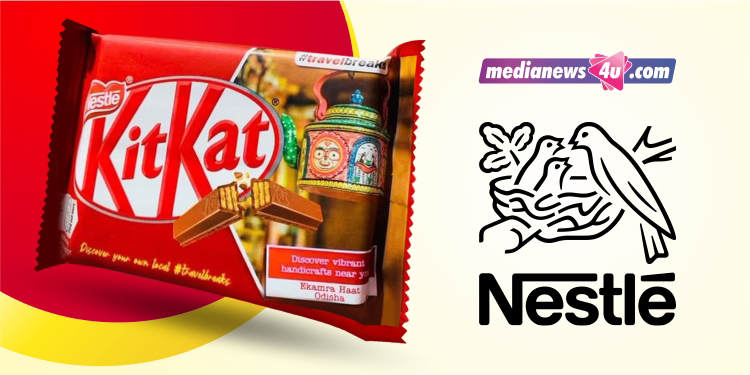Nestle’s special packaging with Hindu Gods and Goddesses was withdrawn after a backlash on Social Media platforms. This special packaging was in tune with their global “Kitkat travel breaks” range. The packaging was to depict the work of local artisans, and the Indian range this year was to celebrate the crafts of Odisha. The wrapper depicted the images of Lord Jagannath, Balabhadra and Mata Subhadra, this was trolled and Nestle had to face the backlash on social media.
There is one question which keeps coming up as to why do brands indulge in this kind of tactics and Why does a renowned brand like Nestle resort to an initiative of this kind?
“I have said this time and again, and I repeat it! Brands must stay away from 2 sacrosanct subjects. 1. Religion. 2. Politics, “ said Harish Bijoor – Brand Guru & Founder – Harish Bijoor Consults Inc.
“World markets are good to notch up on paper and show in boardroom market expansion meetings. But the fact of the matter is there is NO world market. Just like there is NO world brand. There are markets that are local in their cultural and consumption rituals. Just like a true world brand is merely present in many/all markets in the world but has to be a local or even hyperlocal brand in each individual market or culture,” observes Ambarish Ray, Co-Founder and CEO – Digital Dogs Content and Media.
He further added, “Nestle, or any other brand for that matter, that gets a global creative strategy and execution closed in some far away location like the US or Europe, resorts to adaptation and repurpose. This is the bane of trickle down strategies. The developed markets feel that there is no need to understand nuances or even dig deeper than is probably thrown up in the first page of Google to understand local markets and cultures.”
“To be fair, this is an ignorant strategy at best, to me,” he added.
“It is a bit baffling, why such a household name like Nestle and a loved and remembered brand like KitKat would do such a thing,” asks Nishit Nanda, Co-Founder and CEO – Youlry.com.
“As someone who has been a resident of Odisha for decades and knows the market and consumers well, having launched brands and businesses in this market for years, I can vouch for the fact when I say that consumer representation in this market does not need the reliance of religion or gods/goddesses,” he added.
According to him, the strategy by Nestle India is an error in understanding the market.
“It may seem so to the so-called national and international brands that believe India can be cracked with a god’s picture thrown into the mix, but believe me when I say we are far more evolved and complex than that,” he added.
When a country like India has vast cultural opportunities, what’s the relevance of using Hindu Gods for marketing initiatives?
In Ambarish’s opinion, this is a classic case of what Is called the first easy connection.
“Someone must have typed ‘local Indian art forms’ and came across a few images and descriptions and immediately converted that into ‘Hindu God’ art form. A regrettable error in rigour, I would say,” he said.
He further added, “Today, when the supercomputer in our jeans pockets (called the smartphones) has the ability to inform us and literally make us instant experts on any conceivable subject, brands and marketers and teams responsible for global brand and marketing strategies don’t really bother to take the effort. Even to this day, ‘India’ means nothing more to these people than gods, goddesses, poverty, traffic jams and corruption. And a few other generalities like that. ‘Hindu Gods’ itself is such a hornet’s nest.”
“When brands dabble with either, wittingly or unwittingly, they end in controversy and turmoil,” observes Harish.
Nishit believes that the short way home to conclude strategic programmes and quickly get to deployment is the main culprit here.
“Combined with the fact that because of cost reasons and control centers being away from India, these brands are approving global campaigns and basically allowing local markets to only make adaptations. It works probably for homogenous markets but in India, every street corner is a subculture in itself. Just because ‘Hindu’ and ‘Gods’ are immediately SEO-ed in Google.com doesn’t necessarily mean that sums up India,” he points out.
There is a recent trend seen that when people on social media react they are often tagged as RW or communal, is it a right way?
“Consumers are sensitive beings. They do not like to see their deities on disposable packaging that invariably lands up in drains and dustbins,” points out Harish.
“In this case the Nestle effort is innocent. The idea is to get local and promote the culture of Odisha. However, when you use either the names or pictures or icons of Gods on disposable packaging, you are wrong!,” he observes.
According to Ambarish, nothing is really right or wrong in that sense and now, in the metaverse, we are still discovering the rules and rituals.
“What is, however, very incorrect is to create quick labels on behaviour and categorise the people behind those behaviours,” he said.
“Who is to say what is correct and acceptable grammar for taking offence and expressing it? Right Wing or communal is secondary, misunderstood culture and local nuances being called out is the real issue here,” he further added.
According to Nishit, it is not the right process and we must not mistake the content of the pushback with the act of pushing back itself.
“Social media has called out this poor strategy and that is what is important. We cannot expect a wild land of millions of people called social media to behave the way some of us want to,” he added.
Why are brands again & again using hindu gods in their communication, is it to gain instant eyeballs?
“I would tend to agree. It makes for easy OTS (opportunity to see).In a multicultural and multi-theist India, words like “Hindu” and “gods” are more likely to increase the chances of getting noticed,” said Ambarish.
“Brands need to stay careful. Get sensitive. Every brand step, whether it is in product, advertising, packaging or promotion, you need an end-sign off that says that you don’t touch religion or politics!,” said Harish.
“As a brand and marketing leader, I can endorse the fact that today’s strategies are vastly different from yesterday’s PR and marketing decisions,” said Nishit.
“Tried and tested ways to get people excited and even animated don’t work as well or as predictably. For sure, brands repeat this because they see it as a path to quick attention but they fail to see the pitfalls. Instant eyeballs may not always be sustainable attention or even good for the brand’s health,” he added.
Speaking on the entire episodes of controversy and how brands should tackle such campaigns,
Ambarish said, “ Bad press is good PR. Even negative coverage, highly circulated and debated, is better than well thought through strategy that may fail to impress the low-attention world.”
“I understand this is a dance and many brands even fully prepare for the backlash in advance with retracted releases ready and production planned only till the withdrawal phase. I doubt however the wisdom in such strategies – where the short-lived deployment of a purposefully provocative and insensitive strategy will likely get momentary eyeballs but may cause serious damage in the deep association of such brands with their audiences,” he further added.
According to Nishit, Riding cultures and integrating cultural nuances is not just good marketing but also necessary in today’s times.
“We have built an entire consumer and audience programme for youlry.com around the subculture of ‘heist’. However, brands need to understand and deeply go native in that culture and not merely skim the surface from outside the ring,” he said.
“The Odiya artwork that was displayed on the KitKat pack is the cultural iconography of Odisha. At Ekamra haat you can buy many decorative items with the images of Krishna and Balarama, though I admit, you won’t discard it and throw it in the dustbin. I believe it’s better that the brands stay away from all kinds of religious connotations, it will always hurt someone and there is no point wading into that cesspool. It could have been harmless by Nestle, but religious images will create problems,” Naresh concluded.
Dear @NestleIndia # kitkat
Please remove this image of Lord Jagannath Lord Balabhadra and Devi Subhadra from the Rapper of kitkat because people thrown it in dustbin or on drain or if it come out vehicle or people walk on it.
It's Hindu religion issue.Kindly look at this matter. pic.twitter.com/egomRo6yNw— Chandan kumar (@Chandan1Panda) January 13, 2022
This pic of Bhagwan #Jagannath will end up on the road or trash cans. People will walk on it.
Why are pics of Hindu Gods/Goddesses used for marketing?
.@NestleIndia now withdraws the design after backlash. pic.twitter.com/0lHvrF5wsy
— Āyudhika (@Ayudhika1310) January 20, 2022
Nestle India to remove Lord Jagannath's picture on KitKat wrapper after facing backlash https://t.co/k3KBo18DNH
— Republic (@republic) January 19, 2022
Nestle India was on the receiving end of social media's wrath over a wrapper design of its famous product, KitKat. Controversial wrapper features images of Lord Jagannath, Balabhadra & Mata Subhadra, which hurt the religious sentiments of many. #kitkathttps://t.co/PWW2i6slqV
— Ketan (@ketan72) January 20, 2022
Lord Jagannath's pic on KitKat's wrapper sparks outrage on social media; Nestle India reacts #news #dailyhunt https://t.co/igEOmHVvhM
— Dailyhunt (@DailyhuntApp) January 19, 2022
This is one of the worst marketing strategy by @NestleIndia putting Lord Jagannath's picture on the top of wrapper. At the end of the day the wrapper will be disposed in the garbage. We do understand the idea to promote local heritage of ekamrahaat but this is highly unacceptable pic.twitter.com/kUTqoA7vvh
— Rourkela Shines (@RourkelaShines) January 19, 2022

















